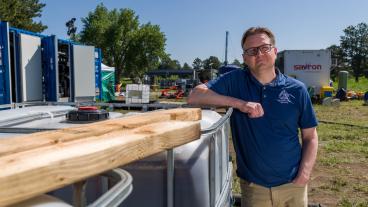Two Colorado School of Mines microbiologists have coauthored an article in the Proceedings of the National Academy of Sciences that examines the widespread impact of a paper, published a quarter-century ago, suggesting that microbial life exists up to several kilometers deep throughout the Earth’s subsurface.
“The deep, hot biosphere: Twenty-five years of retrospection” appears in the July 3, 2017, issue of PNAS and was written by Mines Civil and Environmental Engineering Professor John Spear and postdoctoral fellow Blake Stamps with Montana State University’s Eric Boyd, Saroj Poudel and Daniel Colman.
The authors say “The Deep Hot Biosphere,” written by Thomas Gold and published in PNAS in 1992, “heavily influenced the scientific field of geobiology, bringing together researchers from the disparate fields of geology, geochemistry and microbiology.” Gold’s paper, which was followed by a book with the same title, “forever altered how scientists think about microbial life in the subsurface and its implications for the origins of life on Earth, as well as life beyond our planet,” the authors said.
Gold, an Austrian-born astrophysicist and professor of astronomy at Cornell University, did not have a doctorate, but was a highly recognized scientist. He authored more than 300 papers, and had a tendency to delve into fields beyond his own.
According to Spear et al., “Gold’s deep, hot biosphere contribution challenged paradigms in subsurface science, petroleum research, the origin and evolution of life, and the search for life on other planets.”
While some found logic in Gold’s ideas, and others argued that they were highly flawed, the authors note that they had a tremendous impact on scientific discourse—the article has been cited more than 325 times, often outside the field of astrophysics, and the book remains a top seller on Amazon.
Life on Earth is dependent upon microorganisms in the subsurface—bacteria and archaea—and their ability to cycle and recycle chemical compounds necessary for life on the surface, both deep under continents and under the oceans. But despite intense study in the 25 years since Gold’s paper, the researchers argue that key questions remain about life in the deep subsurface, “including its origins, extent and contribution to hydrocarbon formation worldwide.”
The scientists also touch on emerging data and approaches to studying the subsurface that continue to provide promising new hints toward answering these questions. Their review further expands on how the field of geobiology also may help answer questions relevant to industry such as hydrocarbon degradation, and form beneficial partnerships that would allow further study of the subsurface.
“As Gold suggested, and is becoming increasingly evident, to better understand the subsurface is critical to further understanding the Earth, life, the evolution of life and the potential for life in the solar system and worlds beyond,” researchers said.
The scientists conclude by suggesting the need to develop a robust network of interdisciplinary scientists and accessible locations for long-term monitoring of the Earth’s subsurface in the form of a deep subsurface microbiome initiative. The hope, said Spear, is to be able to understand how Earth functions as a large organism dependent upon something we know biologically little about—the subsurface.
Contact:
Mark Ramirez, Managing Editor, Communications and Marketing | 303-273-3088 | ramirez@mines.edu
Ashley Spurgeon, Assistant Editor, Mines Magazine | 303-273-3959 | aspurgeon@mines.edu



